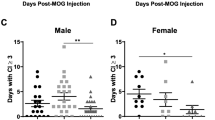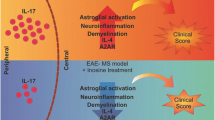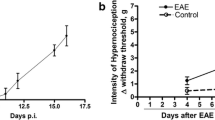Abstract
MOG35-55 triggers chronic, progressive experimental autoimmune encephalomyelitis (EAE) in C57BL/6 mice, and the clinical course of EAE in this model is characterized by macrophage infiltration, axonal demyelination/damage, and progressive paralysis. These stages are usually associated with inflammatory responses in the central nervous system (CNS). This study was designed to investigate the effects of C16, an ανβ3 integrin-binding peptide that targets integrins involved in the transendothelial migration of extravasating inflammatory cells. C16 was applied for only 2 weeks, but the benefits of this therapy lasted at least 8 weeks. Multiple histological and immunohistochemical staining studies, western blotting, enzyme-linked immunosorbent assays, electron microscopy, and cortical somatosensory-evoked potential (c-SEP) electrophysiological tests were employed to assess the degree of inflammation, axonal loss, white matter demyelination, neuronal apoptosis, extent of gliosis, expression of pro-inflammatory cytokines, and functional recovery of differently treated EAE model mice. The results showed that C16 treatment inhibited extensive leukocyte and macrophage accumulation and infiltration, reduced the expression of pro-inflammatory cytokines (tumor necrosis factor-α and interferon-γ), and thereby attenuated and delayed the progression of EAE. Moreover, astrogliosis, demyelination, and axonal and neuronal loss were all alleviated in C16-treated EAE animals, contributing to the improvement of function. These data suggest that the C16 peptide may act as a protective agent by reducing neuroinflammatory responses and improving the microenvironment.








Similar content being viewed by others
References
All AH, Walczak P, Agrawal G, Gorelik M, Lee C, Thakor NV, Bulte JW, Kerr DA (2009) Effect of MOG sensitization on somatosensory evoked potential in Lewis rats. J Neurol Sci 284:81–89
Arnold SA, Hagg T (2011) Anti-inflammatory treatments during the chronic phase of spinal cord injury improve locomotor function in adult mice. J Neurotrauma 28:1995–2002
Balatoni B, Storch MK, Swoboda EM, Schönborn V, Koziel A, Lambrou GN, Hiestand PC, Weissert R, Foster CA (2007) FTY720 sustains and restores neuronal function in the DA rat model of MOG-induced experimental autoimmune encephalomyelitis. Brain Res Bull 74:307–316
Basso AS, Frenkel D, Quintana FJ, Costa-Pinto FA, Petrovic-Stojkovic S, Puckett L, Monsonego A, Bar-Shir A, Engel Y, Gozin M, Weiner HL (2008) Reversal of axonal loss and disability in a mouse model of progressive multiple sclerosis. J Clin Invest 118:1532–1543
Berard JL, Wolak K, Fournier S, David S (2010) Characterization of relapsing-remitting and chronic forms of experimental autoimmune encephalomyelitis in C57BL/6 mice. Glia 58:434–445
Bettini M, Rosenthal K, Evavold BD (2009) Pathogenic MOG-reactive CD8+ T cells require MOG-reactive CD4+ T cells for sustained CNS inflammation during chronic EAE. J Neuroimmunol 213:60–68
Brambilla R, Morton PD, Ashbaugh JJ, Karmally S, Lambertsen KL, Bethea JR (2014) Astrocytes play a key role in EAE pathophysiology by orchestrating in the CNS the inflammatory response of resident and peripheral immune cells and by suppressing remyelination. Glia 62:452–467
Cervellini I, Ghezzi P, Mengozzi M (2013) Therapeutic efficacy of erythropoietin in experimental autoimmune encephalomyelitis in mice, a model of multiple sclerosis. Methods Mol Biol 982:163–173
Crowe MJ, Bresnahan JC, Shuman SL, Masters JN, Beattie MS (1997) Apoptosis and delayed degeneration after spinal cord injury in rats and monkeys. Nat Med 3:73–76
Denic A, Johnson AJ, Bieber AJ, Warrington AE, Rodriguez M, Pirko I (2011) The relevance of animal models in multiple sclerosis research. Pathophysiology 18:21–29
Devaux J, Forni C, Beeton C, Barbaria J, Béraud E, Gola M, Crest M (2003) Myelin basic protein-reactive T cells induce conduction failure in vivo but not in vitro. Neuroreport 14:317–320
Dore-Duffy P, Wencel M, Katyshev V, Cleary K (2011) Chronic mild hypoxia ameliorates chronic inflammatory activity in myelin oligodendrocyte glycoprotein (MOG) peptide induced experimental autoimmune encephalomyelitis (EAE). Adv Exp Med Biol 701:165–173
Fang M, Huang JY, Wang J, Ling SC, Rudd JA, Hu ZY, Xu LH, Yuan ZG, Han S (2011) The anti-neuroinflamatory and neurotrophic effects of combined therapy with Annexin II and Reg-2 on injured spinal cord. Neurosignals 19:16–43
Fang M, Sun Y, Hu Z, Yang J, Davies H, Wang B, Ling S, Han S (2013) C16 peptide shown to prevent leukocyte infiltration and alleviate detrimental inflammation in acute allergic encephalomyelitis model. Neuropharmacology 70C:83–99
Frohman EM, Racke MK, Raine CS (2006) Multiple sclerosis–the plaque and its pathogenesis. N Engl J Med 10:942–955
Garay L, Gonzalez Deniselle MC, Gierman L, Meyer M, Lima A, Roig P, De Nicola AF (2008) Steroid protection in the experimental autoimmune encephalomyelitis model of multiple sclerosis. Neuroimmunomodulation 15:76–83
Ghezzi P, Mennini T (2001) Tumor necrosis factor and motoneuronal degeneration: an open problem. Neuroimmunomodulation 9:178–182
Han S, Arnold SA, Sithu SD, Mahoney ET, Geralds JT, Tran P, Benton RL, Maddie MA, D’Souza SE, Whittemore SR, Hagg T (2010) Rescuing vasculature with intravenous angiopoietin-1 and alpha v beta 3 integrin peptide is protective after spinal cord injury. Brain 133:1026–1042
Hassen GW, Feliberti J, Kesner L, Stracher A, Mokhtarian F (2008) Prevention of axonal injury using calpain inhibitor in chronic progressive experimental autoimmune encephalomyelitis. Brain Res 1236:206–215
Kanwar JR, Kanwar RK, Wang D, Krissansen GW (2000) Prevention of a chronic progressive form of experimental autoimmune encephalomyelitis by an antibody against mucosal addressin cell adhesion molecule-1, given early in the course of disease progression. Immunol Cell Biol 78:641–645
Liu XZ, Xu XM, Hu R, Du C, Zhang SX, McDonald JW, Dong HX, Wu YJ, Fan GS, Jacquin MF, Hsu CY, Choi DW (1997) Neuronal and glial apoptosis after traumatic spinal cord injury. J Neurosci 17:5395–5406
Ma X, Jiang Y, Wu A, Chen X, Pi R, Liu M, Liu Y (2010) Berberine attenuates experimental autoimmune encephalomyelitis in C57 BL/6 mice. PLoS One 5:e13489
Mangas A, Coveñas R, Bodet D, de León M, Duleu S, Geffard M (2008) Evaluation of the effects of a new drug candidate (GEMSP) in a chronic EAE model. Int J Biol Sci 4:150–160
McGavern DB, Murray PD, Rivera-Quiñones C, Schmelzer JD, Low PA, Rodriguez M (2000) Axonal loss results in spinal cord atrophy, electrophysiological abnormalities and neurological deficits following demyelination in a chronic inflammatory model of multiple sclerosis. Brain 123:519–531
Mensah-Brown EP, Shahin A, Al Shamisi M, Lukic ML (2011) Early influx of macrophages determines susceptibility to experimental allergic encephalomyelitis in Dark Agouti (DA) rats. J Neuroimmunol 232:68–74
Merrill JE, Hanak S, Pu SF, Liang J, Dang C, Iglesias-Bregna D, Harvey B, Zhu B, McMonagle-Strucko K (2009) Teriflunomide reduces behavioral, electrophysiological, and histopathological deficits in the Dark Agouti rat model of experimental autoimmune encephalomyelitis. J Neurol 256:89–103
Murugesan N, Paul D, Lemire Y, Shrestha B, Ge S, Pachter JS (2012) Active induction of experimental autoimmune encephalomyelitis by MOG35-55 peptide immunization is associated with differential responses in separate compartments of the choroid plexus. Fluids Barriers CNS 9:15
Nair A, Frederick TJ, Miller SD (2008) Astrocytes in multiple sclerosis: a product of their environment. Cell Mol Life Sci 65:2702–2720
Pifarre P, Prado J, Baltrons MA, Giralt M, Gabarro P, Feinstein DL, Hidalgo J, Garcia A (2011) Sildenafil (Viagra) ameliorates clinical symptoms and neuropathology in a mouse model of multiple sclerosis. Acta Neuropathol 121:499–508
Profyris C, Cheema SS, Zang D, Azari MF, Boyle K, Petratos S (2004) Degenerative and regenerative mechanisms governing spinal cord injury. Neurobiol Dis 15:415–436
Ransohoff RM (2012) Animal models of multiple sclerosis: the good, the bad and the bottom line. Nat Neurosci 15:1074–1077
Roy A, Liu X, Pahan K (2007) Myelin basic protein-primed T cells induce neurotrophins in glial cells via alphavbeta3 integrin. J Biol Chem 282:32222–32232
Shu Y, Yang Y, Qiu W, Lu Z, Li Y, Bao J, Feng M, Hu X (2011) Neuroprotection by ulinastatin in experimental autoimmune encephalomyelitis. Neurochem Res 36:1969–1977
Slavin A, Ewing C, Liu J, Ichikawa M, Slavin J, Bernard CC (1998) Induction of a multiple sclerosis-like disease in mice with an immunodominantepitope of myelin oligodendrocyte glycoprotein. Autoimmunity 28:109–120
Soulika AM, Lee E, McCauley E, Miers L, Bannerman P, Pleasure D (2009) Initiation and progression of axonopathy in experimental autoimmune encephalomyelitis. J Neurosci 29:14965–14979
Tanoue K, Yamashita S, Masuko K, Osaka J, Iai M, Yamada M (2006) Two cases of acute disseminated encephalomyelitis which occurred before the age of 24 months. No To Hattatsu 38:363–367
Tegla CA, Cudrici C, Rus V, Ito T, Vlaicu S, Singh A, Rus H (2009) Neuroprotective effects of the complement terminal pathway during demyelination: implications for oligodendrocyte survival. J Neuroimmunol 213:3–11
Troncoso E, Muller D, Czellar S, Zoltan Kiss J (2000) Epicranial sensory evoked potential recordings for repeated assessment of cortical functions in mice. J Neurosci Methods 97:51–58
Troncoso E, Muller D, Korodi K, Steimer T, Welker E, Kiss JZ (2004) Recovery of evoked potentials, metabolic activity and behavior in a mouse model of somatosensory cortex lesion: role of the neural cell adhesion molecule (NCAM). Cereb Cortex 14:332–341
Voskuhl RR, Peterson RS, Song B, Ao Y, Morales LB, Tiwari-Woodruff S, Sofroniew MV (2009) Reactive astrocytes form scar-like perivascular barriers to leukocytes during adaptive immune inflammation of the CNS. J Neurosci 29:11511–11522
Warden P, Bamber NI, Li H, Esposito A, Ahmad KA, Hsu CY, Xu XM (2001) Delayed glial cell death following Wallerian degeneration in white matter tracts after spinal cord dorsal column cordotomy in adult rats. Exp Neurol 168:213–224
Weerasinghe D, McHugh KP, Ross FP, Brown EJ, Gisler RH, Imhof BA (1998) A role for the alphavbeta3 integrin in the transmigration of monocytes. J Cell Biol 142:595–607
Xu J, Drew PD (2007) Peroxisome proliferator-activated receptor-gamma agonists suppress the production of IL-12 family cytokines by activated glia. J Immunol 178:1904–1913
Xu J, Chavis JA, Racke MK, Drew PD (2006) Peroxisome proliferator-activated receptor-alpha and retinoid X receptor agonists inhibit inflammatory responses of astrocytes. J Neuroimmunol 176:95–105
Yin JX, Tu JL, Lin HJ, Shi FD, Liu RL, Zhao CB, Coons SW, Kuniyoshi S, Shi J (2010) Centrally administered pertussis toxin inhibits microglia migration to the spinal cord and prevents dissemination of disease in an EAE mouse model. PLoS One 5:e12400
Acknowledgments
This work was funded by the Zhejiang Provincial Natural Science Foundation of China no. R2110025 and the National Natural Science Foundation of China, project no. 81271333.
Conflict of Interest
The authors declare that they have no conflicts of interest.
Author information
Authors and Affiliations
Corresponding author
Electronic supplementary material
Below is the link to the electronic supplementary material.
ESM 1
(PDF 1778 kb)
Rights and permissions
About this article
Cite this article
Zhang, F., Yang, J., Jiang, H. et al. An ανβ3 Integrin-Binding Peptide Ameliorates Symptoms of Chronic Progressive Experimental Autoimmune Encephalomyelitis by Alleviating Neuroinflammatory Responses in Mice. J Neuroimmune Pharmacol 9, 399–412 (2014). https://doi.org/10.1007/s11481-014-9532-6
Received:
Accepted:
Published:
Issue Date:
DOI: https://doi.org/10.1007/s11481-014-9532-6




